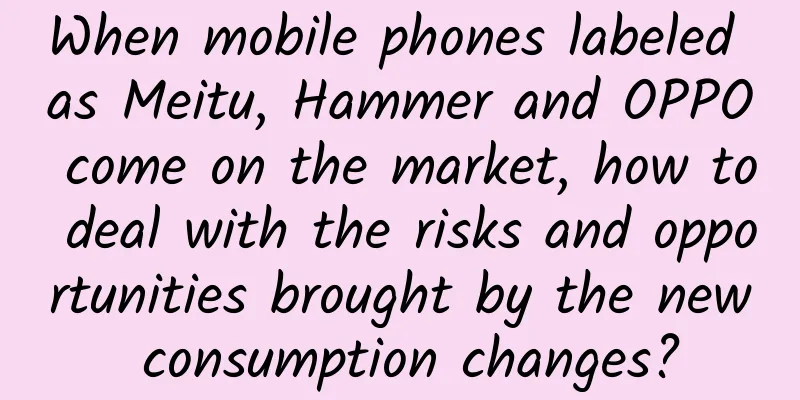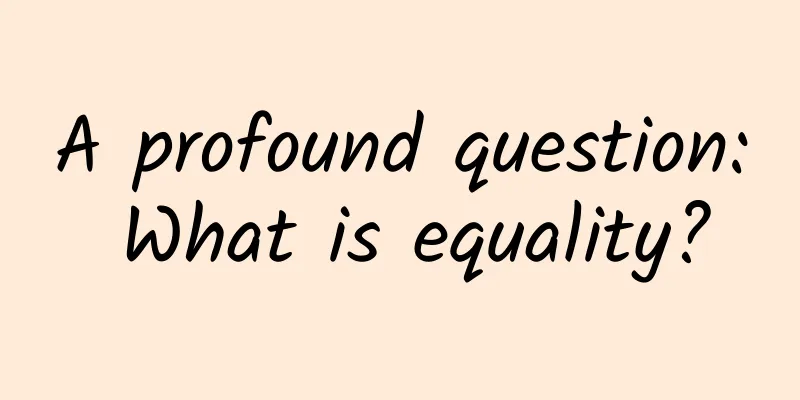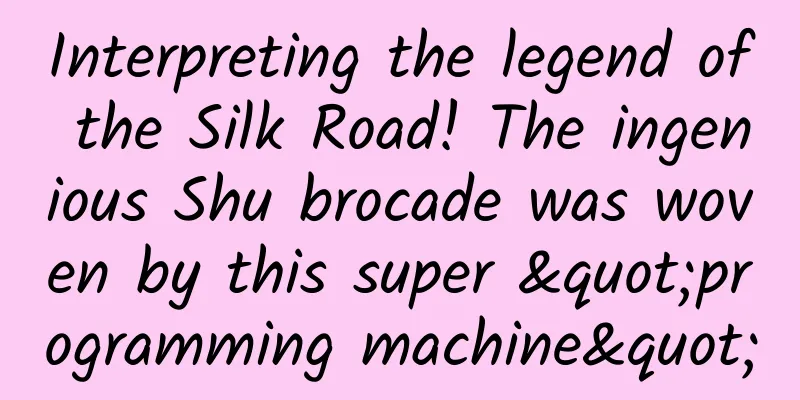When mobile phones labeled as Meitu, Hammer and OPPO come on the market, how to deal with the risks and opportunities brought by the new consumption changes?

|
The representation of a consumer brand in the minds of users is often extremely subjective, simple, and stereotyped. Conversely, for consumer brands, this simple labeling is actually the result of long-term instillation of distinctive brand concepts. Whether good or bad, it is ultimately the result of the superposition of various factors. For example, after being used by the heads of state of two countries, Russia's YotaPhone was long nicknamed the "head of state phone"; after Meitu, which focuses on the appearance economy, launched the Meitu phone, it was also regarded as a "selfie artifact"; of course, the Hammer was also packaged by Luo Yonghao in a shocking style as "the best phone in the Eastern Hemisphere." Of course, in addition to these clear-cut mobile phone brands, some brands have also inadvertently weakened their individual labels. The recently released Meizu MX6 is still a good phone in my opinion, but what? Because the emphasis on fast charging, an individual function of the MX6, cannot cover up the lack of overall selling points, because fast charging, as a concrete label, has long been exclusive to OPPO. Just like Xiaomi's "born for fever" marketing, it is clear-cut and objectively erects a marketing barrier. Of course, fundamentally speaking, the normalized upgrade of the mobile phone industry will form a terrible generation gap when it encounters the upgrade of consumption patterns, and the mobile phone supply side will need to bear most of the pain and changes brought about by this generation gap, because the supply side is like a train, and it is always difficult to escape the range of the demand track. The mainstreaming of new consumption patterns Before we talk about the mainstreaming of new consumption patterns, let’s first look at what new consumption patterns are. In my opinion, current consumption is shifting from “rational consumption” to “emotional consumption”, that is, the importance of practicality and quality is fading, while feelings and sensations are becoming new dominant factors in consumption. This transformation of consumption concepts is the new consumption pattern. The new normal of consumption naturally has new consumption characteristics, and this characteristic often has a distinct and different form of expression, that is, the customers of mass consumer brands are being decomposed into vertical consumer groups, and the characteristic, unique and subjective consumption concepts are becoming the external manifestation of the reconstruction of the superstructure (consumer demand) caused by the upgrading and change of the economic base (consumption power). If expressed in the terminology of the real estate industry, it can be called improvement demand. The emergence of selfie phones led by Meitu has been recognized and welcomed by the market, but if Meitu phones appeared in the 2g era, would they win the market? Obviously not. Because people's functional needs for mobile phones have not been resolved. Improvement demand has become the biggest driving force for the entire mobile phone industry to upgrade, and this decentralized demand is the result of the increasingly obvious trend of long-tail distribution of consumer groups. The entire industry is undergoing vertical decomposition, and its foundation relies on two conditions, namely big data and the Internet. (1) Big data, aside from the complex professional terms, simply means recording the behavior of a large number of samples and labeling each sample to create a user profile. For example, Meitu Inc. once conducted a big data survey, and its data not only showed that girls like to take selfies, but also that users born after 1990 are the mainstream users of selfies; from a regional perspective, users in Guangdong Province prefer to take selfies; big data can even display user characteristics such as industry and zodiac sign, thus forming a user data profile. For mobile phone brands, they only need to extract labels to find those that meet the standards, and then use precise positioning marketing, just like delivering medicine directly to the lesion. This is simpler and more efficient than the previous method of looking for a needle in a haystack. In short, big data allows brands to easily locate vertical consumer groups. (2) From the user's perspective, the Internet's virtual shelves make the user's access cost lower; as Chris Anderson said, the long tail market is the result of the activation of certain factors dormant in the "economics of abundance", and this result has led to the 80/20 rule that has long dominated traditional industries being replaced by the 98% rule. Among mass brands, companies such as Apple and Samsung cannot fill this demand gap, but the Internet and the big data based on it allow all long-tail demands to be discovered and met. Under the new consumption normal, upgrading of the mobile phone industry is imperative. However, in the process of change, there are also landmines and opportunities lurking. "Dangers and opportunities" under the new consumption revolution The butterfly effect that started from the transformation of the consumer side often reshaped the industry structure when it was transmitted to the supply side. When people were tired of the same old feature phones, no matter how Nokia made breakthroughs in product design at that time, it was ultimately difficult to tap into consumers' real curiosity. However, the iPhone, which seemed to have mediocre functions and a poor user experience at the time, unexpectedly took over the entire mobile phone industry. This is the potential huge consumer demand activated by the good combination of consumption change and supply change. Of course, the rise of Apple also sent Nokia and Sony to their graves. The "dangers and opportunities" brought about by the transformation of consumption patterns were vividly demonstrated at this moment. And now, this familiar situation is once again being put before many mobile phone manufacturers: With the high concentration of the mobile phone supply chain, components, processes, materials and other hardware parts have already formed a relatively standard and fixed set of templates. All-metal body, fast charging, high-definition screen, etc. have long become standard features of smartphones. All upgrades to these modules have become pale and powerless, just like standing on a skyscraper. People are already mentally numb to the height of a few meters. Therefore, the minor upgrades of many functions of Meizu MX6, such as fast charging, imaging effects, mobile payment and other functions, although quite sincere, are still criticized by many users for having no characteristics; one can even see comments like "Please give me a reason to choose MX6" on WeChat Moments. This is a typical product of the mass consumption concept, that is, striving to find a balance between product upgrades and mass users, and still adhering to the idea of moderation to win the favor of mass consumers. Obviously, this is contrary to the trend. The biggest difference between MX6 and PRO6 lies in the price range, not the experience or hardware design. For the "rational consumption" model, price is often the key to competitiveness, but for the "emotional consumption" model, price is becoming a secondary factor in the selection logic. Single point breakthrough is an opportunity in the dilemma of mobile phone homogeneity When the entire mobile phone industry faces a bottleneck in function upgrades, the dilemma of homogenization often follows. Don’t always rely on consumer loyalty to maintain normalcy, because the relationship between consumers and brands is often far from forming a purchasing motivation. Sony mobile phones were abandoned in the belief that "Sony Dafa is good." These major challenges can be summarized as: experience innovation, brand innovation, and value concept. A single breakthrough in mobile phone upgrades can be seen as a single substance that is transformed into three different substances after a reaction. Let's take a few brand cases to illustrate this: First, in the overall homogeneity, the experience perception that a single breakthrough can bring is significantly higher than a small upgrade. For example, Meitu Company developed the Meitu mobile phone with beauty as its core function, combining various celebrity effects, internet celebrity effects, and beauty apps such as Beauty Camera and Meitu XiuXiu to create a coveted appearance ecosystem, so that it can be labeled as a "selfie artifact", which proves that in terms of experience perception, Meitu has broken through the dilemma of homogeneity and formed a new experience different from any previous mobile phone. Second, a joke was popular online a few years ago: "There are only two kinds of mobile phones in the world, one is called iPhone, and the other is other mobile phones." In terms of brand innovation, OPPO was the first to realize that fast charging was a breakthrough point, and vigorously promoted "charge for five minutes, talk for two hours", so that when talking about fast charging, OPPO must be mentioned. Latercomers, such as Huawei, Meizu, Xiaomi, etc., have done well, but they cannot break through OPPO's fast charging concept. This is the bonus of being the first to try it. Third, the single-point breakthrough method of mobile phone innovation has another important byproduct, which is the ability to form a unique brand value concept. This can be seen as a user "screener" that extracts consumers who pursue differentiation and personalization from the huge consumer group that had to follow the big wave of consumption in the past. This is the case with Hammer phones, Meitu phones, and OPPO. The rise of niche brands is all due to unique single-point breakthrough innovation. It is precisely because of the vertical reconstruction of user needs that they are able to capture more long-tail demand users who were once ignored or had no choice from the users of mass consumer brands. This article was authorized by Li Yuyang to be published on Huxiu.com and edited by Huxiu.com. Original link: http://www.huxiu.com/article/157214/1.html As a winner of Toutiao's Qingyun Plan and Baijiahao's Bai+ Plan, the 2019 Baidu Digital Author of the Year, the Baijiahao's Most Popular Author in the Technology Field, the 2019 Sogou Technology and Culture Author, and the 2021 Baijiahao Quarterly Influential Creator, he has won many awards, including the 2013 Sohu Best Industry Media Person, the 2015 China New Media Entrepreneurship Competition Beijing Third Place, the 2015 Guangmang Experience Award, the 2015 China New Media Entrepreneurship Competition Finals Third Place, and the 2018 Baidu Dynamic Annual Powerful Celebrity. |
>>: Domestic mobile phones are quietly experiencing a price increase. Will consumers pay for them?
Recommend
Southerners: Why do we need to scrub our bodies? Northerners: It can remove dead skin cells!
Tell me quietly, are you from the north or the so...
This "white plague" caused Lin Daiyu to die and Lu Xun to pass away. You and I may be infected!
It is the disease that has killed the most humans...
【Creative Cultivation Program】Where is Newton's apple?
Author: The Nutcracker Studio The great scientist...
Whose birds are back? Check out this Beijing Spring Bird Watching Guide →
As spring arrives and flowers bloom, migratory bi...
Goodbye! iPhone jailbreaking is dead
I believe many friends still remember "PP As...
New breakthrough in hydrogel 3D printing! "Using softness to make hardness" to achieve complex structure ceramics
Produced by: Science Popularization China Author:...
Kugou million traffic project practice
When I work on growth for a project, it is like a...
Apple Watch 2's new system is a tragedy that directly bricks it
Apple recently pushed a new system, watchOS 3.1.1...
3 key points to discuss the strategy of hot-selling products
There are a wide variety of products today, and t...
"Perfect Diary" brand marketing template!
The rapid popularity of Perfect Diary , a domesti...
Musk becomes the world's richest man, is the secret the "first principles"?
Musk is the richest man in the world, and he owns...
How does Baidu bidding analyze the market?
Before bidding analysis, you should first pay att...
CES 2015 laptop and tablet preview: Microsoft returns with a bang
On January 5, the US International Consumer Elect...
The Hotan-Ruoqiang Railway officially opens to traffic today, encircling the Taklimakan Desert
June 16 Hotan-Ruoqiang Railway (hereinafter refer...









